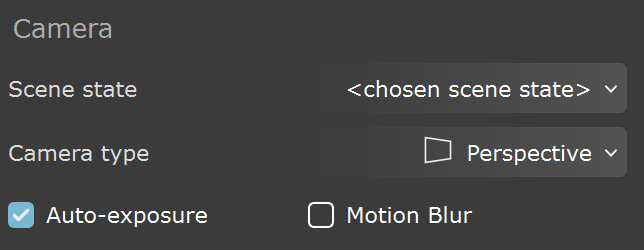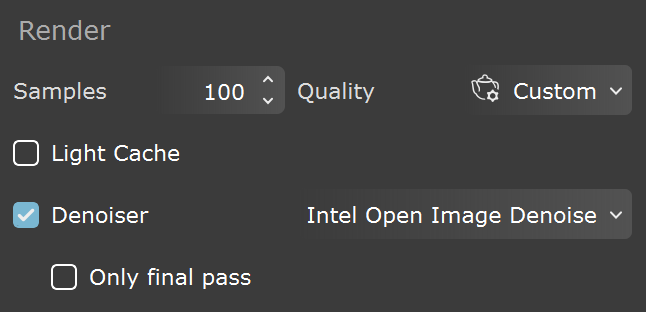This page provides information about the Render animation with Chaos Vantage MAX script.
Overview
The Render animation with Chaos Vantage MAX script helps you to send and render your animated 3ds Max scene to Chaos Vantage with a click of a button.
Installation
The installation of the tool comes with the installation of V-Ray 5 for 3ds Max, update 2 and later.
UI Path
To access the script, in 3ds Max go to ||Vantage toolbar|| > Render animation with Chaos Vantage ().
Settings
When clicking on the Render animation with Chaos Vantage () button, the following dialog appears:
Render camera – Specifies from which camera to render the animation. Only VRayPhysical and Max Physical cameras are supported. Field cannot be empty.
Refresh – Refreshes the list of available cameras. Must be pressed to updates the list if a camera has been added to the scene while the dialog is opened.
Next – Continues to Chaos Vantage for additional settings.
Cancel – Closes the dialog.
When clicking Next, the following dialog appears in Chaos Vantage:
Camera
Scene state – Specifies the rendering camera from a list of available scene cameras or <current camera> position.
Camera type – Specifies the type of the camera to be used when rendering a snapshot.
Perspective – Sets the current scene camera to be used to render the snapshot.
Cube 6x1 – Sets the use of a Box camera with the cube sides arranged in a single row useful in generating cubic VR output.
Stereo Cube 6x1 – Sets the use of a Left/Right stereo Box camera with the cube sides arranged in a single row useful in generating cubic stereo VR output.
Spherical – Sets the use of a spherical camera with independent horizontal (FOV X) and vertical (FOV Y) FOV selection that is useful for generating latlong images for spherical VR use.
Stereo spherical – Sets the use of a spherical Left/Right stereo camera with independent horizontal (FOV X) and vertical (FOV Y) FOV selection and that is useful for generating latlong images for spherical VR use. The stereo strength can be adjusted by modifying the Eye dist parameter.
Orthographic – Sets the use of an orthographic camera with an Orthographic width.
FOV X – Specifies the horizontal field-of-view angle. Available only when Camera Type is set to Spherical or Stereo spherical.
FOV Y – Specifies the vertical field-of-view angle. Available only when Camera Type is set to Spherical or Stereo spherical.
Eye dist – Specifies the eye distance for which the stereoscopic image is rendered. Available only when Camera Type is set to Stereo Cube 6x1 or Stereo spherical.
Focus rotation – When enabled, the left and right views are rotated so that their focus points coincide at the distance specified by the Focus Distance parameter in the Camera tab. When disabled, the left and right views directions are parallel.
Top/Bottom – When enabled, the output layout for the views is Top(for left eye) and Bottom(for right eye). When disabled, the output layout is Left(for left eye) and Right(for right eye).
Orthographic width – Specifies the the width (in scene units) of the orthographic camera. It controls how much of a scene the camera can see and has the same effect as zooming a perspective camera.
Auto-exposure – When enabled, exposure is automatically calculated for each frame. Set exposure in camera is ignored.
Motion Blur – Enables the rendering of motion blur for the rendered image with the settings set in File > Advance Scene Settings > Camera > Exposure time.
Resolution
Width – Sets the width of the rendered snapshot in pixels.
Height – Sets the height of the rendered snapshot in pixels.
Preset – Sets the render resolution from several predefined resolutions:
PC Video; NTSC; PAL; 540p; HD720p; 900p; FHD 1080p
Aspect - Sets the aspect of the render resolution.
Lock aspect – When enabled, locks the Width value to the Height value. When changing the Height value, the Width changes proportionally according to the Aspect value.
Render
Samples – Specifies the samples per pixel for refining the image.
Quality – Sets the rendering quality based on 4 predefined presets:
Low – Sets the rendering quality using the following values:
GI – Off;
GI bounces – 1;
Reflection bounces – 2;
Refraction bounces – 4;
Coat – On;
Shading graph – Off;
Noise threshold – 0.5;
Opacity maps(clip) – Off;
Shading graph for glossy/GI – Off;
Medium – Sets the rendering quality using the following settings:
GI - On;
GI bounces – 2;
Reflection bounces – 2;
Refraction bounces – 8;
Coat – On;
Shading graph – On;
Noise threshold – 0.1;
Opacity maps(clip) – Off;
Shading graph for glossy/GI – Off;
High – Sets the rendering quality using the following settings:
GI – On;
GI bounces – 3;
Reflection bounces – 8;
Refraction bounces – 8;
Coat – On;
Shading graph – On;
Noise threshold – 0.05;
Opacity maps(clip) – On;
Shading graph for glossy/GI – Off;
Ultra – Sets the rendering quality using the following settings:
GI – On;
GI bounces – 4;
Reflection bounces – 15;
Refraction bounces – 15;
Coat – On;
Shading graph – On
Noise threshold – 0.01;
Opacity maps(clip) – On;
Shading graph for glossy/GI – On;
Custom – Sets the rendering quality using the settings from the Render settings tab.
Light Cache – Enables Light Cache when rendering.
Denoiser – When enabled, applies denoising to the rendered image. It allows choosing between the NVIDIA AI denoiser or Intel Open Image Denoise. Denoiser amount is 0, when disabled or 100, when enabled.
NVIDIA AI – Vantage's integration of NVIDIA's AI-based denoising algorithm. The NVIDIA AI denoiser requires an NVIDIA GPU to work.
Intel Open Image Denoise – Vantage's integration of Intel Open Image Denoise.
Only final pass – Applies the denoiser only during the final pass. This greatly reduces render time when used with high Samples count.
Reduce flickering – Enables temporal rendering of the AI denoiser. Results and details may be blurry when enabled. Disabling it may increase image sharpness.
Render elements
Render Elements – When enabled, outputs render elements for use in compositing software. Specific render elements can be set from the Setup button.
Separate files – When enabled, render elements are generated into separate files. When disabled, render elements are stored into a single file. Note: exr file must be specified as an output file.
Setup – Opens the Render elements selection dialog.
Output
Frame range
First frame – Specifies the first frame of the animation sequence.
Last frame – Specifies the last frame of the animation sequence.
Interval – Specifies the frame output at regular intervals.1 renders every frame of the animation while for example 5 renders every 5th frame.
FPS – Specifies the frames per second for the animation.
Custom frames
Specify custom frame – Specifies custom frames and/or frame ranges to render. Example: 1, 5, 7-25, 50-100.
Output file type – Specifies the file type for the rendered sequence.
Image – Output of the animation is an image sequence. In the Save Image window, a .png or .exr file format can be specified for the image sequence.
Image + MP4 – Output of the animation is an image sequence and an .mp4 file. In the Save Image window, a .png or .exr file format can be specified for the image sequence.
Image + MKV – Output of the animation is an image sequence and an .mkv file. In the Save Image window, a .png or .exr file format can be specified for the image sequence.
MP4 – Output of the animation is an .mp4 file.
MKV – Output of the animation is an .mkv file.
Save PNG alpha – When enabled, stores the environment in the alpha channel of the .png file. In the Save Image window, a .png file format must be specified.
Output path – Specifies the output file path where the still image is saved.
In the Save Image window, a .png or .exr file type must be added after the specified file name:
e.g Camera01.png or Camera01.exr
If an .exr file type is specified, the following render elements are automatically generated and saved in it:
- Background
- Bumped Normals
- Self-illumination
- Velcity
- Z-depth
Set values and parameters are auto saved and will be used between sessions.
Memory requirements
Pixel buffers – The amount of additional memory required for the currently set render resolution.
Approx. GPU memory needed – Displays an approximation of the needed GPU memory for the currently set render resolution and settings.
Start – Starts rendering of the set Camera and current render settings. Button is disabled if there are cameras in the batch rendering queue.
Cancel – Closes the Render setup dialog.
Usage
To use the script, first start Chaos Vantage and then click on the Render animation with Chaos Vantage button and a live link session will be initialized between 3ds Max and Chaos Vantage. The script will automatically:
- Detect if you are using V-Ray 5 GPU as a renderer and ask if you would like to switch to it
- Send the scene to Chaos Vantage on 20701 port with the specified settings
- Render each frame from the specified range in the specified location
To stop a Live Link session, click again on the Initiate Live Link to Vantage button.







